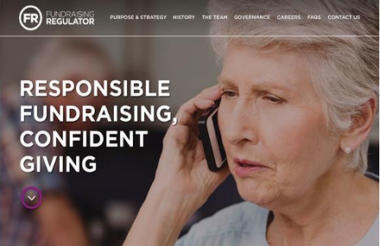Less than a year on from its official launch the Fundraising Regulator is in financial difficulties. Responsibility for this rests partly but not entirely at the door of the regulator itself, writes Hugh Radojev.
As we reported in some depth last week, the Fundraising Regulator has found itself in financial difficulties, after missing its own targets on the first round of its levy on fundraising spend.
The regulator aimed to raise at least £2.2m from its levy on fundraising charities, and said it might be rendered “ineffective” if it raised less than £1.96m, or was forced to reduce its running costs.
It now expects to raise around 10 per cent less than this minimum target, meaning it will almost certainly have to pare back its regulatory function.
The regulator's high refusal rate also brings into question how much support it enjoys among those it regulates. Given the adage that one cannot govern without the consent of the regulated, this is a concern.
As things stand currently, around 35 per cent of charities invoiced by the Fundraising Regulator at the end of last year have either refused to contribute, are likely to refuse, or should never have been asked to contribute in the first place. And it seems highly unlikely that the second round of levy invoicing will see these figures significantly improve.
How did this happen?
There are many reasons why the levy has been problematic, and we have to apportion responsibility among a number of the principals in this drama.
Part of the problem stems from the circumstances of the regulator's establishment, which led to 219 incorrect invoices being issued. The Fundraising Regulator was hampered from day one by both a lack of financial and staff resource, as well as external governmental pressure to get up and running as fast as possible. The regulator had to beg the country's 50 largest charities for start-up money, and did not really have the capital it needed to get going.
Then the Charity Commission provided faulty data. This is something the regulator should maybe have anticipated, but some of the blame must lie with the Commission, and some with the people who filed the wrong information in the first place.
The larger part of the problem, though, is obviously the refusal of many charities to pay.
The Fundraising Regulator has pointed the finger at a lot of "smaller charities" for failing to contribute, but admits that a handful of larger organisations have yet to pay. Five large charities: The British Museum, Médecins Sans Frontières, RNIB, the Roman Catholic Diocese of Westminster and the Tate, all originally refused to contribute to the Fundraising Regulator's start-up costs before it launched last year.
However, both the RNIB and the British Museum later agreed to contribute and to pay the levy.
The regulator obviously feels aggrieved at the stance taken by the non-paying charities. Failure to support the levy, in the regulator's view, betrays a lack of support for the wider sector and lack of respect for donors. It feels that not paying is petulant, and betrays a victim mentality.
This is not wholly fair, but nor is it wholly without merit. Some charities are at fault for not paying - that must depend on the individual circumstances of the organisations involved. But on the other hand, if they feel aggrieved, it is perhaps because the regulator's communications with the sector have provided opportunity and motive to feel that way.
There have been three main problems.
Lord Grade
First, there has been a lack of solid leadership from the organisation’s figurehead and chair, Lord Grade of Yarmouth, whose preferred form of communication with the sector is through aggressive comments to national media outlets that have been, at best, met with consternation by the sector.
Having a peer on board may have lent the organisation the political heft and clout it needed - and pleased Rob Wilson, then the minister for civil society. But to be frank, when it comes to obtaining the consent of the regulated, Lord Grade has not been as helpful as he might have been.
The invoicing process
As we reported at the time, the Fundraising Regulator rolled out its levy invoices in stages beginning with the UK’s very largest organisations in September last year. According to the regulator, a template letter was sent to each of the chief executives of the organisations “explaining the levy payment is voluntary” before the invoices were sent.
I’ve since spoken to a number of small and medium-sized organisations that reported issues with the regulator’s invoicing process, with many saying it was poorly explained and a few saying it was aggressively worded. A number also said that if they raised an invoice issue, the regulator often took weeks to respond, which meant that conversations dragged on almost interminably.
A handful even made a comparison between the regulator’s “sending out unsolicited ‘begging letters’” for its levy and the sort of industrial-scale fundraising techniques that had landed larger UK fundraising charities in hot water, and led to the creation of the Fundraising Regulator in the first place.
One, Children and the Arts, was so upset it took the issue to its local Trading Standards.
A clear failure to communicate
Third, compounding the problems of the invoicing process, the Fundraising Regulator has arguably failed to properly communicate with smaller organisations as to why they should contribute.
In the weeks after the regulator launched, I sat down with a member of staff from the Small Charities Coalition, who said the regulator was effectively treating the SCC – a tiny organisation with only a handful of full-time staff – as the de facto representative of all UK-based small charities.
While the SCC was clearly encouraged at the time that the regulator was reaching out to it, the spokesperson said the SCC had made it clear that the regulator needed to do more to reach out to this important part of the charity sector.
The hardest part of the job for the Fundraising Regulator was always going to be getting small and medium-sized fundraising charities to buy into the idea that paying for a regulator was in their best interests. This process appears not to have been wholly successful.
What now?
In a statement issued last week, Stephen Dunmore, chief executive of the Fundraising Regulator, denied that the regulator was running on reserves. However, he did admit that the take up of the levy’s first round had been poorer than expected, and said his organisation has now revised down its budget to £1.8m.
In Fundraising Magazine
Perhaps the most concerning part for the sector is the fact that Dunmore also firmly set out the regulator’s stall when it comes to the possibility, if not now probability, of the levy being moved to a statutory basis.
“We have been clear, as has the government, that fundraising regulation is not optional," he said. "Ministers hold reserve powers to impose both fundraising regulation and the levy on a statutory basis."
The sector now faces a stark choice: either pay up, or accept the fact that by this time next year, the levy -and by extension the regulator itself - will be a statutory one.
Related Articles












